Archived Mold Remediation Blog Posts
Mold Remediation for Commercial Properties in Fort Worth, Texas
7/1/2024 (Permalink)
Managing commercial properties comes with a host of responsibilities, and ensuring a mold-free environment is a critical aspect that often gets overlooked. At SERVPRO of North Richland Hills, we recognize the unique challenges faced by commercial property managers in Fort Worth, Texas. Our franchise is a licensed Texas Mold Remediation Contractor with over a decade of experience. We’ve helped thousands of property owners and managers, and we can help you, too.
This guide aims to empower commercial property managers in Fort Worth, Texas, by providing essential knowledge and actionable steps for mold prevention and remediation, ensuring the safety and longevity of their properties. We provide an in-depth look into mold remediation for commercial properties, emphasizing the importance of professional intervention and preventive measures.
Hidden Mold in Commercial Properties
Mold thrives in moist, humid environments and can quickly become a significant issue in commercial settings. Fort Worth's climate, with its hot summers and potential for high humidity, creates an ideal environment for mold growth. Mold can damage property, making it essential to address any signs of mold promptly.
Indicators of Mold in Commercial Properties
Identifying mold early can save you time and money. Here are some common signs of mold in commercial buildings:
- Unpleasant Odors: A persistent, musty smell can indicate mold, even if it's not visible. If you or any of your tenants experience this smell, it’s time to investigate for potential mold growth.
- Visible Mold Growth: Mold can appear as black, green, or white patches on walls, ceilings, or floors. Typically, mold growth happens in areas of high humidity, such as bathrooms and kitchens.
- Water Damage: Past incidents of water damage, like leaks or flooding, can lead to mold growth if not properly addressed. Even small cracks around windows or doors can eventually cause water pooling and mold if left untreated.
Why Professional Mold Remediation is Crucial for Commercial Properties
DIY mold removal is not recommended for commercial properties due to the scale and complexity involved. Professional mold remediation ensures complete and safe removal. Here’s why it’s essential:
- Comprehensive Inspection: Mold remediation professionals conduct thorough inspections to detect mold in hidden areas, ensuring no mold is left untreated. SERVPRO of NRH uses sophisticated cameras to find hidden wet spots behind walls, which are usually areas of high mold growth potential.
- Advanced Techniques and Equipment: SERVPRO of NRH uses state-of-the-art equipment and methods, and our mold removal professionals can effectively remove mold and prevent future growth.
- Health and Safety: Proper protective gear and containment strategies minimize health risks during the remediation process. Our technicians are Texas-certified Mold Remediation Workers and Contractors.
- Long-Term Prevention: SERVPRO mold experts can provide recommendations to prevent future mold growth, protecting your property and its occupants.
The Mold Remediation Process at SERVPRO of North Richland Hills
At SERVPRO of North Richland Hills, we follow a meticulous process to ensure your commercial property is mold-free.
- Detailed Inspection and Assessment
Our trained technicians begin with a comprehensive inspection to assess the extent of mold damage. This includes checking for hidden mold in HVAC systems, behind walls, and under flooring.
- Containment
To prevent mold spores from spreading, we establish containment areas using physical barriers and negative air pressure techniques.
- Air Filtration
We employ advanced air filtration systems, including HEPA vacuums and air scrubbers, to capture mold spores from the air and ensure a clean environment.
- Mold Removal
Using antifungal and antimicrobial treatments, we eliminate mold colonies and prevent new ones from forming. This step may involve removing and disposing of heavily affected materials like drywall or carpeting.
- Cleaning and Sanitizing
All affected items, such as furniture, documents, and equipment, are thoroughly cleaned and sanitized. We also deodorize the space to eliminate any musty odors.
- Restoration
The final step involves restoring your property to its pre-mold condition. This can include minor repairs, like replacing drywall and painting, or reconstruction, depending on the severity of the mold damage.
Preventive Measures for Mold in Commercial Properties
Preventing mold is far more cost-effective than remediation. Here are some preventive measures:
- Humidity Control: Use dehumidifiers and ensure proper ventilation, especially in areas prone to moisture.
- Regular Maintenance: Promptly address any leaks in plumbing, roofs, or HVAC systems to prevent moisture buildup.
- Routine Inspections: Schedule regular mold inspections, particularly after any water damage incidents.
- Educate Occupants: Inform tenants and employees about the signs of mold and encourage prompt reporting of any issues.
Partner with SERVPRO of North Richland Hills for Expert Mold Remediation
Mold remediation in commercial properties requires a thorough, professional approach to ensure the safety and health of all occupants. At SERVPRO of North Richland Hills, we are dedicated to providing top-tier mold remediation services using the latest technology and methods.
If you suspect mold in your commercial property, don’t hesitate. Contact us today for a comprehensive inspection and professional mold remediation services. Protect your investment and ensure a healthy environment for your tenants and employees.
Signs of Mold Infestation
4/24/2023 (Permalink)
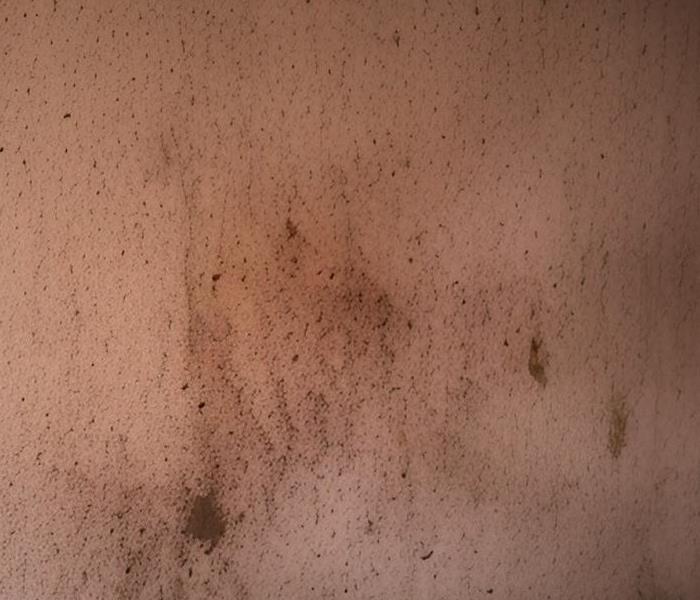 SERVPRO of NRH is a Texas-licensed mold remediation contractor. Call us anytime for mold removal help.
SERVPRO of NRH is a Texas-licensed mold remediation contractor. Call us anytime for mold removal help.
What is Mold?
Mold, a fungus that prospers indoors and outdoors, rapidly spreads through air-borne spores in moist conditions. It progressively weakens the structures it grows on and generates foul odors.
Though a natural and unpreventable aspect of the environment, mold can become problematic when it proliferates excessively inside buildings. We recommend familiarizing yourself with sure telltale signs of mold growth in buildings and other indoor zones to quickly identify and address the issue.
Signs of Mold Infestation
One noticeable sign of mold growth is a musty or unpleasant odor. The scent of mold is unique and has typically been described as damp, earthy, or stale. Even when mold is not visible, its pungent odor emanates due to the exudation of Volatile Organic Compounds (VOCs) from the microbial activities of molds.
Discoloration or staining on walls, roofs, or floors highlights another unmistakable sign of mold growth. Usually manifesting as clusters of black, brown, or green spots, mold may also cause fuzzy or cotton-like textures on surfaces, further indicating its existence. It is also seen that molds cause discolorations and staining on fabrics such as curtains and upholstery.
Investigating for signs of mold growth after experiencing water damage like leaks or flooding is essential, and such scenarios provide conducive conditions for molds to thrive. In such cases, it is necessary to engage professional water-damage cleaning services to minimize mold harboring promptly.
Suppose any of the above signs of mold growth are evident. In that case, it is advisable to immediately seek the services of professional mold remediation specialists to examine, contain, and eradicate them wherever necessary.
Who to Call for Mold Remediation
Mold remediation contractors are professionals with specialized expertise who are entrusted with removing mold from indoor environments and buildings. These specialists possess extensive knowledge of how different types of mold thrive in moist surroundings and have the necessary equipment and materials to efficiently and promptly mitigate mold-related problems.
In Texas, mold remediation contractors must be licensed to perform mold removal services, and technicians present during the mold remediation process must also be certified. This emphasis on certification ensures that mold remediation professionals have undergone the required training to effectively carry out their work and offer their clients a high level of service.
Notably, any mold that extends over an area of 25 contiguous square feet should be reported to the relevant Texas authorities. It is imperative to select a contractor with expertise and experience in the remediating mold of this size, and they should agree to handle all required paperwork.
Choosing a qualified mold contractor necessitates thorough consideration beyond licensing and certification. Verify that state licenses are in place, ensure that certified technicians are present, and remember to take advantage of a contractor's knowledge in navigating state and local paperwork related to mold remediation. Ensure the contractor can act as a partner, assisting you in navigating the remediation process while dealing with all mold-related paperwork.
SERVPRO of North Richland Hill's Mold Remediation Process
SERVPRO of North Richland Hills is a highly professional mold remediation contractor that employs a comprehensive process for identifying sources of mold growth. We conduct a rigorous visual inspection of the property to detect all signs of visible mold growth. SERVPRO meticulously examines every aspect of the property to identify even the most subtle trace of mold growth.
To further support our inspections, SERVPRO employs advanced equipment and techniques to identify and detect mold growth sources that are not visible. For instance, moisture meters are utilized to detect moisture levels in a suspected area, as high moisture levels generally indicate the presence of mold. Similarly, infrared cameras capture images of temperature differences, and variations in temperature or wet spots are telltale signs of hidden mold growth, which we can detect and isolate quickly.
Once mold growth sources are located, we devise a customized plan to remove the mold. This plan considers all potential causes of mold growth, and one critical step in the program is reducing moisture levels in the affected area. This may involve installing dehumidifiers, air movers, and specialized drying equipment to remove excess moisture from the air and surfaces, ensuring the indoor environment is dry and unfavorable for mold growth.
Our SERVPRO mold team may suggest modifications to your HVAC system or ventilation, as these can significantly influence the ability to maintain proper moisture levels inside your property. Good airflow inside the property can help prevent moisture buildup and reduce the risk of mold growth.
Then, we will implement measures to isolate the affected area and seal it off from the rest of the property. This involves covering floors and walls with plastic sheeting while sealing all openings. It is imperative to prevent mold spores from spreading to other parts of the property, and this tactic achieves this goal.
Next, we dispose of any porous materials contaminated with mold, such as insulation or drywall, because cleaning these effectively is impossible. Conversely, disinfecting non-porous materials such as metal, tile, and concrete is practicable.
After eliminating contaminated materials, our contractors initiate a rigorous cleaning process using special HEPA vacuums and air filtration devices. This removes mold spores from both surfaces and the air, after which we use a biocide solution to kill any surviving mold spores, creating a barrier between cleaned surfaces and mold, thwarting further spread.
It is vital to remember that covering or painting over mold growth is not a solution, and such attempts are short-lived and will not prevent mold from growing. For this reason, we ensure all our mold remediation work meets rigorous guidelines and industry standards to sanitize the property correctly.
At SERVPRO of North Richland Hills, we use cutting-edge technological solutions for remediation work, such as dry ice blasting. This method uses dry ice pellets to extract mold spores from surfaces without damaging the underlying material.
We are a remediation contractor and licensed Esporta Wash Operator, which means we can sanitize and restore mold-infested textiles like plush animals, blankets, shoes, and more. Even though mold-infected contents can be restored, they are packed and sent to our cleaning facilities before returning.
SERVPRO of North Richland Hills remediation contractors not only eliminate mold growth but also investigate potential future water intrusion problems and other sources of water damage. This critical step is needed to prevent mold growth recurrence and ensure the property's safety.
To investigate potential water intrusion issues, we inspect the property's exterior for visible signs of water damage, such as leaks, cracks, or foundation damage. We repair any identified problems to prevent further water intrusion.
Mold growth due to faulty plumbing or drainage issues is a possibility that should not be taken lightly. Our mold remediation team uses inspection techniques such as camera technology to detect leaks or damages in plumbing systems. Such sources are then repaired, preventing further infiltration, water damage, or mold growth. This repair process may involve fixing damaged pipes, unblocking drainage systems, repairing damaged roofs, or sealing cracks.
The next critical step in our mold remediation process is to identify any possible entry points for water (a mold growth promoter) and prevent moisture buildup by sealing them off. This involves detailed property inspections to detect penetrations, cracks, or gaps vulnerable to water infiltration. Water entry points are sealed using various techniques such as sealants, caulks, patches, or plugs, creating a water barrier to prevent mold growth.
To further prevent mold and water damage on the property, waterproof membranes shield vulnerable surfaces, including walls and floors, from water intrusion. SERVPRO, through identifying vulnerability points and sealing penetrations, can eliminate current mold issues and reduce the risk of future occurrences.
Call Today for a Complimentary Mold Bid
Call SERVPRO of North Richland Hills for a complimentary mold remediation bid. Our team of mold experts and ready and Here to Help.
How to Keep Your Furniture from Molding in Self-storage Units
11/12/2021 (Permalink)
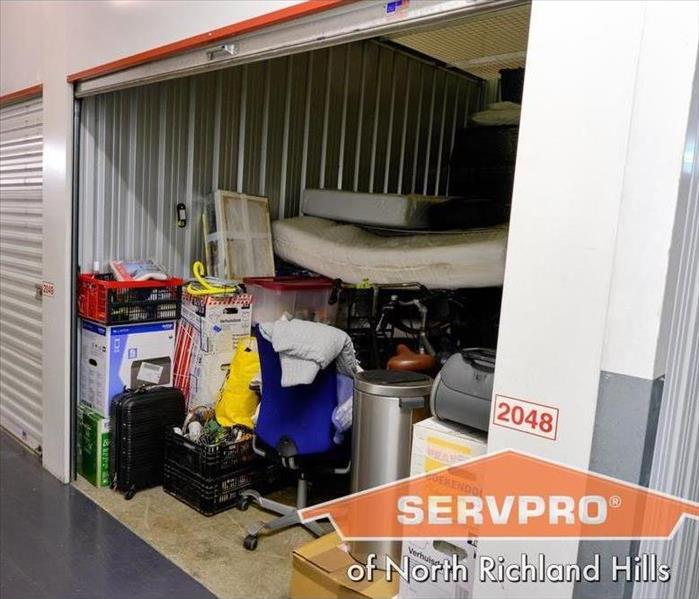 SERVPRO of North Richland Hills mold remediation experts are more than happy to provide these services.
SERVPRO of North Richland Hills mold remediation experts are more than happy to provide these services.
Mold is a home and business owner’s worst enemy that grows practically anywhere year-round. And the worst thing about mold is that you can never eliminate it entirely.
Mold spores and particles are always present in the atmosphere. No matter how much maintenance or restoration you do, there will still be some deposits lingering in your home or commercial business. More so, there will always be some lingering on your furniture that you put in self-storage units.
It’s easy to forget about your belongings once they’re safely tucked away in storage units, simply because we tend to think they’re protected from the elements.
The truth, however, is that your furniture can be susceptible to damage in ways you may not think possible inside a storage unit. In some cases, that damage can include mold. Before you realize it, it will spread all across your stored furniture. By then, you’ll need to hire someone for Fort Worth mold remediation.
SERVPRO of North Richland Hills mold remediation experts are more than happy to provide these services. But to make sure mold will never strike again, continue reading below to see how you can keep your furniture from molding in self-storage units.
How Do You Control Mold?
It’s said that you can’t really control Mother Nature. But that’s not necessarily true. When it comes to mold, you just need to control the moisture inside your storage unit to prevent its growth.
Moisture is what allows mold to develop and spread. When moisture is in your storage unit, mold will easily grow across your furniture. So, to prevent mold from growing, keeping a dry environment in the unit is a must.
How Do You Control Moisture in a Self-Storage Unit?
There are a few things you can do to control the moisture in your storage unit. They include:
Installing a Moisture Barrier
You can add extra protection to your furniture when you install a moisture barrier inside your storage unit.
By just placing a tarp or plastic sheet on the floor, you provide a barrier that prevents moisture in the floor from seeping into your belongings.
Use Moisture-Absorbing Products
Certain products can absorb moisture from the air and surfaces, such as charcoal briquettes and silica gel packs.
By taking these products and placing them in a fabric pocket, you can place them around the storage unit where they will absorb moisture and help prevent mold growth. Remember to change them periodically, though.
Further Steps You Can Take
Besides controlling the moisture, other steps you can take involve cleaning your furniture and drying it before storage.
You can also store your furniture away from the door and walls since moisture will likely seep in through small crevices under doorways and cracks.
Lastly, another way you can prevent molding on your furniture is by placing items in a way that allows optimal airflow. When choosing a storage unit, choose one that’s fairly big enough and provides enough airflow around your furniture pieces.
Molded Furniture? Call SERVPRO Right Away
If your furniture has too much mold for you to handle, let our professionals take care of it. Our staff is trained to provide expert Fort Worth mold remediation services and when we’re done, we feel confident you’ll be satisfied with our work.
Call us today at (817) 589-1499 or visit our contact page to schedule a free consultation.
Suspect Mold? Follow These Mold Safety Tips for Your Fort Worth Home
9/23/2021 (Permalink)
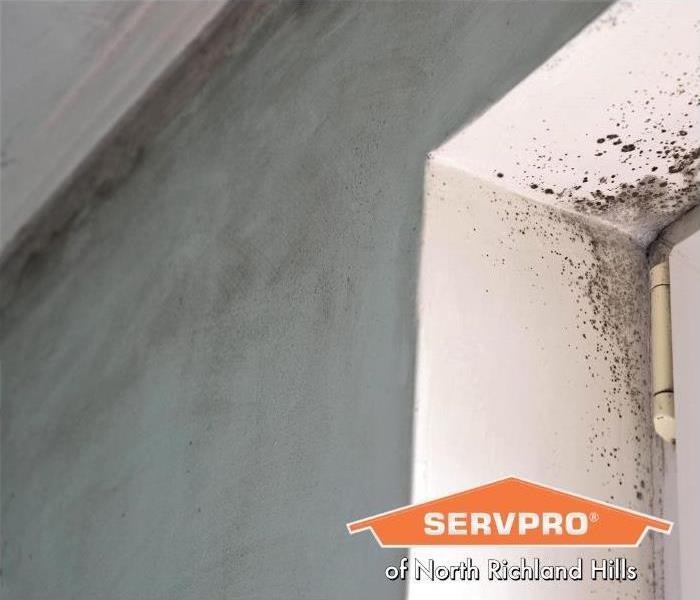 Sometimes, the only way to get rid of a mold problem is to reach out to a professional mold removal contractor.
Sometimes, the only way to get rid of a mold problem is to reach out to a professional mold removal contractor.
Mold doesn’t need perfect environmental conditions to get started and is very common in and outside homes. Supplied with just a little warmth, water, or moisture, it can quickly begin to spread throughout your house. And, once it gets started, safely removing mold can be challenging. The three tips we’ll share with you will help you deal with mold without putting your health in danger. Use Proper Equipment When Cleaning
When removing mold, use a half-face respirator paired with a proper mold filter. As you remove mold from your walls, spores will get into the air and your lungs unless you wear a mask. Wearing the appropriate mask and filter can eliminate up to 99.9% of mold particles.
If you want to go a step further, you can purchase a full-face mask, but this is a more expensive and often unnecessary choice. Additional protective equipment includes rubber gloves, protective eyewear, and full-body clothing.
Inspect Your HVAC System Before Cleaning the Mold
When cleaning the mold, especially with harsh chemicals like bleach, you want to have proper ventilation. That said, don’t use your HVAC system unless you are entirely sure that it’s not contaminated with mold.
In mold-infested households, HVAC systems are seldom free from mold. Most often, mold appears near the intake to the system. So, before cleaning the mold or applying any harsh chemicals, check if your HVAC can run without potentially spreading mold throughout your entire household.
Don’t Vacuum the Mold.
Vacuuming can temporarily increase your exposure to mold spores. As the spores can pass through an ordinary vacuum bag, they’ll instantaneously end up in the air and can stay there for hours, sometimes days. Only vacuum the mold if you have a central vacuum that vents outside or a regular vacuum with HEPA filters that trap mold spores.
Need a Mold Specialist? Contact Us Today
Sometimes, the only way to get rid of a mold problem is to reach out to a professional mold removal contractor. If you’ve found yourself in such a situation, the mold removal experts at SERVPRO North Richland Hills can help you tackle your mold problem.
With extensive mold removal experience and the latest equipment, our professionals can take care of your mold problems and restore your home to a healthy, mold-free condition.
Don’t expose yourself to the detrimental effects mold can have on your health. Contact us today at (817) 589-1499 for prompt and efficient mold removal.
What’s the Difference Between Mold Removal and Mold Remediation?
7/26/2021 (Permalink)
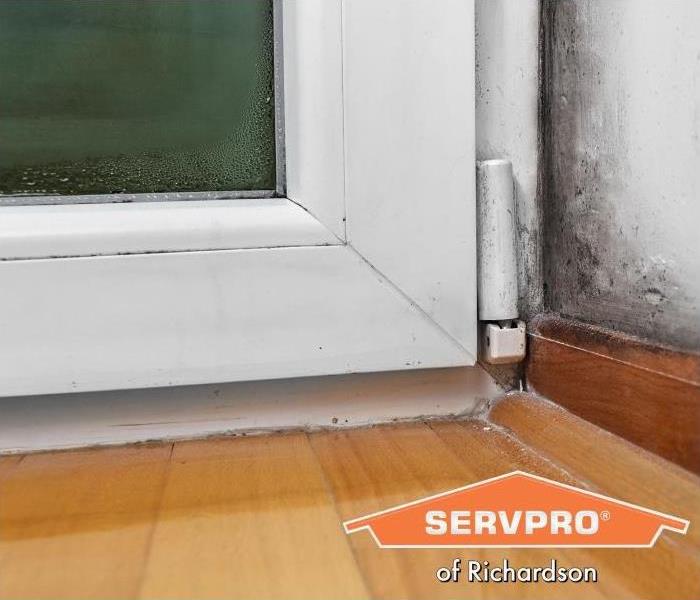 Mold is a pervasive organism that can be tough to remove but not impossible.
Mold is a pervasive organism that can be tough to remove but not impossible.
Uh oh. Those aren’t stars you’re seeing. They’re mold spots on the wall. Mold is a pervasive organism that can be tough to remove but not impossible. If you’re looking for professional help to get rid of stubborn mold, you’ve probably come across the terms mold remediation and mold removal in your search.
So, what’s the difference? And how will it impact your wallet and time spent waiting for a mold-free building? We’ll explore the difference between mold removal and mold remediation below.
Let’s Get This Mold Myth Out of the Way First
Mold is everywhere. It plays an important role in the breakdown of organic material. So the bottom line is, you can never completely get rid of mold in the environment.
If a company tells you they will completely get rid of the mold, and it will never return, they’re not being entirely honest with you. Mold is all around us. If you have mold professionally cleaned and removed from your property, you have to do your part to ensure that it doesn’t regrow.
What Mold Needs to Grow
Mold needs high humidity levels and an organic food source to grow. You’ll need to keep humidity levels below 50% to prevent mold from forming a colony and impacting your indoor air quality.
Spills, leaks, and floods must be cleaned asap — within 48 hours — to prevent mold from forming. Unfortunately, mold also likes to munch on paint. Use a mold-killing primer to stop mold from growing on the walls.
The bottom line is, a professional company like SERVPRO North Richland Hills can clean and remove mold from your home or commercial building. But if you don’t keep humidity levels low, then the mold will return.
The Main Difference Between Mold Remediation and Mold Removal
These terms are often used interchangeably in the restoration and construction industry. But essentially, mold removal is the physical process of removing mold spots and colonies. Mold remediation focuses on returning mold to normal levels that don't impact air quality.
Bear in mind that complete removal of mold spores is impossible. This is because spores are microscopic and are prolific in indoor and outdoor air. But keeping humidity levels at an acceptable level will prevent the mold spores from taking hold and forming spots and colonies where they start to break down materials, causing further damage to your property.
Professional Mold Remediation and Removal
If you were to contact a professional company for mold remediation and removal, what they’ll do is engage in the process of cleaning the mold, restoring any damaged materials, and returning the mold to acceptable levels.
This may include disaster cleanup after a flood or water damage from extinguishing a fire. Or cleanup from plumbing and roof leaks.
Mold Remediation in North Richland Hills
Are you dealing with unsightly mold spots in your home or commercial building? Our professional mold remediation services can get your building restored to a mold-free state in a jiffy.
We’re available 24/7. Give us a call at (817) 589-1499 for a free estimate.
Homes of Fort Worth - How to Get Rid of Attic Mold
1/5/2021 (Permalink)
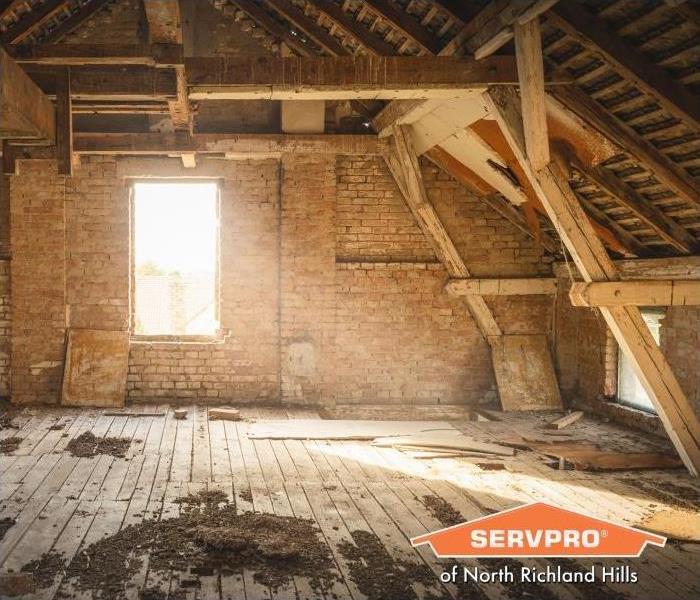 If you find or suspect mold in your attic, contact SERVPRO in fort worth for professional mold remediation services.
If you find or suspect mold in your attic, contact SERVPRO in fort worth for professional mold remediation services.
You wouldn’t expect an attic to have the freshest of air, but one day you climb the ladder to retrieve your holiday decorations from this lofty storage and notice it’s more than just dusty. The attic smells musty.
Attic mold isn’t necessarily a health hazard as the living space air doesn’t usually mix with that in the attic, but mold in the attic is no less destructive. Black mold in the attic may destroy construction materials such as rafters and insulation. Depending on the cause, the mold may spread through the ceiling.
Because we rarely go up to the attic, finding mold up there comes as a surprise. Does mold found in the attic during a home inspection affect the value of the home? Some may wonder if they should buy or sell a home with attic mold issues.
Attic mold remediation is something you should certainly do sooner than later, but it doesn’t mean a house is unfit to be sold. SERVPRO Fort Worth is here to keep homes and businesses mold-free. Read on to learn about how mold develops in the attic and what to do about it.
Causes of Mold in the Attic
Mold likes to grow where it’s damp and dark. Below are common causes of mold in the attic:
- Moisture is trapped in construction materials. Say the timber for the rafter wood was rained on. If it doesn’t dry thoroughly, mold might grow there.
- Condensation forms in the attic space cold air from outdoors meets warm air from indoors (or vice versa, perhaps). One solution for this is improved insulation.
- Mold grows where wood construction is dampened because ventilation is insufficient or blocked. There should be about one square foot of venting per 100 square feet of space.
- Moisture can enter the attic if there are exhaust system leaks from bathroom fans or appliances that pass through the attic space.
- Discoloration or water stains on rafters, sheathing, joists, fascia boards, or flashings indicate a roof leak. Mold grows from the rainwater that enters the attic this way.
Mold needs moisture to thrive so a dry attic is a mold-free attic. Check the roofing, the vents, the perimeter of attic windows, plumbing stacks, chimneys, etc. for where moisture becomes trapped in the attic.
Is Mold in Attic Common?
How often do you go up to the attic? Most people may not go up to the attic but once a year, if that. How rare it is for human eyes and ears to observe the attic makes it more likely that a moisture issue won’t be caught in time before mold starts to form.
Mold and mildew in the attic are more common than you might think. Mold is likely to grow in dark, out-of-the-way places with plenty of moisture and cellulose material to consume. Just add water, and an attic is a perfect place for mold to grow.
How Much is Mold Remediation in Attic?
Fort Worth mold remediation costs depend on the extent of the mold damage including square footage of the affected area, and to what degree the mold has ravaged materials.
Compare Home Advisor local rates to the national average costs.
Cost Range of Mold Remediation for the Dallas/Fort Worth Metroplex
- Average total: $2,167
- Typical total: $1,355 - $3,357
- Low-end cost: $525
- High-end cost: $5,700
National Average Cost Range of Mold Remediation
- Average total: $2,220
- Typical total: $1,116 - $3,330
- Low-end cost: $375
- High-end cost: $6,000
The above figures are from an outside source and do not necessarily reflect the attic mold remediation costs for SERVPRO of Fort Worth. Call us any time for pricing information!
Should I Buy a House With Mold in the Attic?
Mold in the home is a concern for anyone looking to acquire property. Mold growth isolated to the attic isn’t necessarily a reason to pass on a house, but the source of the problem must be addressed.
When mold is found in the attic is during a home inspection, simply removing the infected materials isn’t enough to resolve the problem. Without finding and repairing the cause of water and moisture problems, the mold problem will continue to resurface.
How to Remove Mold in Attic
Attic mold remediation is more than just removing mold that is visible. The issues that allowed the mold to grow in the first place must be addressed, otherwise, the mold will just grow back.
Finding the source of the problem of moisture or water getting trapped in the attic begins with some troubleshooting. Having the trained eye of a professional helps to accurately diagnose the problem.
Where is the mold showing? Using a bright flashlight, mark all of the places where you see mold growth. Is it directly under the roof? Is it near any plumbing? Or by a place where a bathroom fan or kitchen appliance’s exhaust path is? Where are puddles or dampness?
Depending on where you find these problems, this is where you would investigate first. The roof, exhaust systems, or plumbing issues would need to be repaired.
If you suspect a moisture trap problem, then the ventilation set up needs some review. Do you have enough vents? Are the existing vents blocked? Soffit vents should be clear to optimize airflow. All vents need to be oriented to flow outside of the attic and remain unobstructed.
Other issues that may be allowing moisture, condensation, and water into the attic are clogged rain gutters or attic window issues.
Sources of trapped moisture and causes of water puddles may be difficult to pinpoint. There might also be multiple issues that contribute to mold growth. Hiring a professional to diagnose the issue is usually the best way to resolve the issues and that will keep your attic dry. Mold remediation steps may vary, but below is a general outline of SERVPRO’s procedures:
- Inspection and mold damage assessment: We’re equipped to identify different types of mold and comb over the areas where mold likes to hide.
- Mold containment: We seal off the area so as to properly manage the remediation process.
- Air filtration: We vacuum the air for purifications. Mold spores exist naturally in the air, so they can’t all be removed, but we remove as much toxic mold as we can.
- Removing mold and mold-infested materials: We use industrial cleaning agents to remove mold from surfaces. We also discard items that are severely contaminated. We safely remove your storage items from the attic during the remediation process.
- Cleaning contents and belongings: Our goal is to preserve rather than replace, so we salvage whatever possible. Contaminated soft goods can be restored to food-grade cleanliness in our industrial Esporta Wash System.
- Restoration: If we have to disassemble and remove construction materials in the attic space during the remediation, we bring it back to its preloss state by replacing these with new materials.
Mold Remediation Experts Ready in Fort Worth
Mold removal from the attic is a combination of resolving issues so you can maintain a dry space while eradicating existing mold colonies. Once these things are under control, your attic goes back to being something you don’t think about.
SERVPRO of North Richland Hills has been fighting mold in spaces of all sizes for decades. Our years of experience allow us to quickly pinpoint sources of moisture and dampness that cause your mold issues - even in dark and cramped places like your attic.
If you’re buying a home, selling a property, or just want to solve an attic moisture problem before a mold issue develops, call SERVPRO for attic mold remediation consultation and pricing information at (817) 589-1499.
How to Get Rid of Mold Mites
10/16/2020 (Permalink)
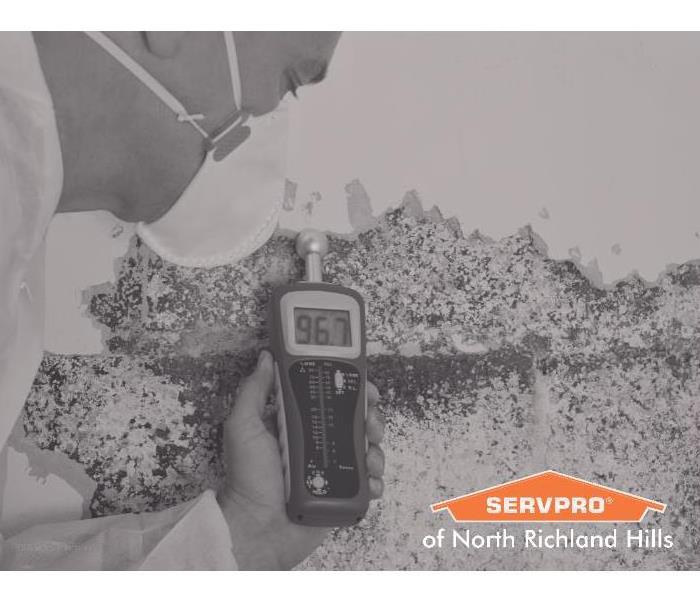 Contact SERVPRO for professional mold remediation services in Fort Worth.
Contact SERVPRO for professional mold remediation services in Fort Worth.
How many living things are inside your house? Of course, you count your family and your pets, but microorganisms and sometimes pests find their way inside to share the dwelling.
As the expert mold fighters in Fort Worth, Texas, SERVPRO has a thorough understanding of how mold behaves. Here are a few facts about mold:
- What mold eats: Mold likes to hang around in a building or house because of the abundance of cellulose materials it can consume like drywall, paper, fabrics, carpet, wood, etc.
- What eats mold: Mold is a part of a grand life cycle. Mold consumes matter, and in turn, other living things consume mold like fungus gnats, booklice, and mold mites. Slugs, roaches, camel crickets, and millipedes are attracted to mold because they want the organic matter that mold breaks down.
So several creatures use mold as a food source, but today we’ll focus on mold mites. When you remove mold colonies from your home, you are likely to remove numerous mold mites that gather to feast on it.
What Are Mold Mites?
The formal name for mold mites is tyophagus putescentiae. Other names for these tiny critters are cheese mites, “putrid cheese eater,” meat mites, flour mites, or computer mites. While they resemble insects, they are not. Mold mites are arthropods and are related to ticks.
Mold mites are hairy and white or tan in color. They are very hard to see as they are no larger than a crumb. Speaking of small bits, thousands of mold mites will congregate on a very small piece of mold. When they cluster together, it’s easier to spot them. If you spot mold, chances are there are mold mites present.
How to Identify Mold Mite Bites
Something bit you. Was it a mold mite? If a mite bit you, it was more likely a chigger than a mold mite. Mold mites do not bite humans, but you might end up with a rash, or red bumps from them (that could be mistaken for mold mite bite). Their long hairs irritate the skin of those who are allergy-prone and may feel like a bite.
If you spend enough time in a mold-infested environment, you may end up with some stinging and itching from mold mites. This is an adverse reaction rather than a bite.
How to Get Rid of Mold Mites
Mold mites rarely come into contact with humans or bother them, but even so, many homeowners are bothered by any insect-like creature being indoors.
Mold and bugs both thrive in warm, humid areas. Moisture finds its way into your home in many different ways such as faulty roofs, leaky pipes, unventilated bathrooms, spills, drafts, or through the crawlspace. Mold needs a relative humidity of 70 percent or higher at temperatures below 60 degrees to flourish.
Like any pest, the most effective mold mite treatment is to take away what brought them inside in the first place - mold. By taking away their food source, mold mites won’t have a reason to come back. Stop attracting mold mites with the prevention tips below.
- Remove or clean mold-infested items in all areas of your home.
- Open your windows to let some light and fresh air in. Ventilation and sunlight inhibit mold growth.
- Purge your pantry and fridge of expired food.
- Wipe down surfaces with hot water and soap. Make sure to dry surfaces thoroughly. Follow up with a disinfectant and go by the instruction label exactly. Some products must sit for a while before being wiped away.
- Pull excess moisture from the air by using a dehumidifier.
- Remove any dead or dying plants in or around your home. Remember, mold is a natural decomposer, so dying organic material is a prime target.
How to get rid of mold mites in your house is as simple as removing their food source so they stick to finding sources of mold out in nature instead.
Flooding and Mold Mites
If a home or building doesn’t have a mold problem already, a water emergency (such as flooding) creates an opportunity for mold to take root. Mold will start to grow in a flood-affected structure within 24-48 hours of the incident.
As we said earlier, measures taken to eliminate mold remove the conditions that invite mold mites to move in. The best way to avoid toxic mold growth is to do a complete and thorough water damage cleanup.
The more extensive the water damage and saturation, the more likely it is that you’ll need professional water damage recovery services. If you’re in the middle of a water emergency mess and you’re not sure what to do, call us at SERVPRO. We’ll answer your questions on how to proceed, and we’ll even do a free consultation.
Professional Cleaning Services & Mold Removal in Fort Worth
SERVPRO of North Richland Hills is not a pest control service, but we can remove the mold that attracted these mites in the first place. We offer complete water damage restoration to prevent mold growth, or a thorough mold remediation if mold is discovered. With our technicians donning the proper personal protective equipment we can get close to the mold so you don’t have to.
SERVPRO is a trusted brand in professional cleaning for Fort Worth properties. We have advanced equipment, industrial-grade cleaners, and the best technician training in the industry. When you encounter water damage, or you suspect there may be mold, call us at (817) 589-1499 for a complimentary quote!
Found Mold in Your Dishwasher? Here's What the Fort Worth Experts Say to Do.
8/19/2020 (Permalink)
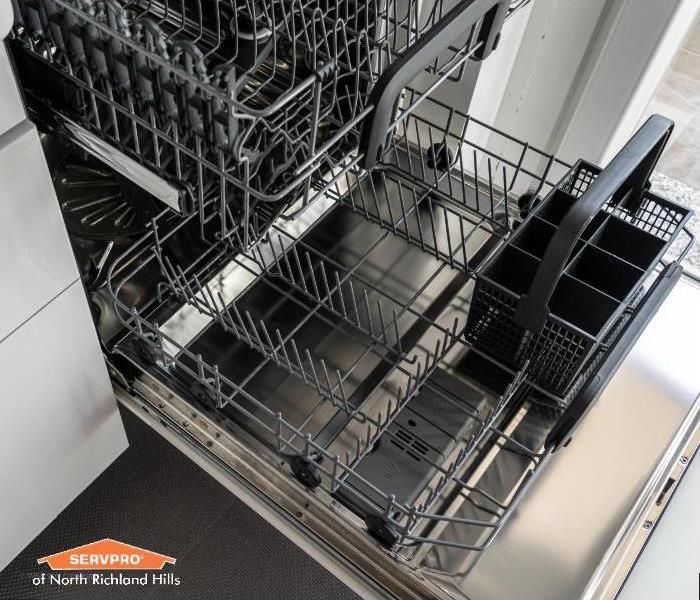 If you have stubborn mold in your dishwasher, contact the Fort Worth mold remediation professionals at SERVPRO.
If you have stubborn mold in your dishwasher, contact the Fort Worth mold remediation professionals at SERVPRO.
When we think about dishwasher appliances we think clean and sanitary. We trust it to do a better job than handwashing.
The truth is, a dishwasher is the perfect place for mold to grow. Steam from the humidity, ample moisture from the water cycle, darkness, and food particles are everything mold spores need to thrive.
So, why is there mold in your dishwasher? Wouldn’t a hot drying cycle and potent detergents kill off microbes? Not exactly. Mold can live through repeated dishwashing cycles. Mold likes the heat the dishwasher gives off and the detergent may be an unintended food source for the mold.
Mold is an unwelcome guest in your cleaning apparatuses. You wouldn’t want it anywhere around items you want to be sanitary, so you should be aware and proactive to keep mold in a dishwasher at bay.
At SERVPRO in Fort Worth, we are the mold experts. We’ll show you what to do when you discover you have a moldy dishwasher.
Why Is There Mold in My Dishwasher?
Mold makes its presence known with a pungent and musty smell or dark mold spots appear.
A dishwasher has all the right conditions for mold growth. This environment collects bits of food, is dark, warm, and has ample moisture.
Mold likes to grow on food that is left near the drain area and hides in places like crevices and rubber parts. To be specific, these areas are seals around the door, drain covers, and gaskets.
Mold spores end up trapped inside the dishwasher and make themselves at home in its Goldilocks environment.
Common Causes of a Moldy Dishwasher
The design that keeps water inside for the cleaning process is also a primary factor in mold growth. For the water to stay inside the dishwasher, the door must be sealed, and because it’s sealed off, it doesn’t get adequate ventilation.
Airflow is needed to keep mold spores from settling. Once the mold spores are trapped in the apparatus, there is the opportunity for mold to grow.
Clogged drains, leaks around hoses, and a lack of cleaning care also contribute to mold growth.
Dishwashers are designed to clean, not all are self-cleaning. Just like a clothes washer, they need regular cleaning.
How to Get Rid of Mold in Your Dishwasher
An appliance that is intended to keep things clean should also be kept clean. When you see mold spots or an odor indicates mildew is in the dishwasher, it’s due for a cleaning. Here is how to clean mold in the dishwasher.
Note: Bleach is commonly used to clean mold, but it’s not appropriate for cleaning the dishwasher (because it can damage the parts). We recommend you opt for vinegar or soap and water when cleaning a moldy dishwasher. Lemon juice works well as a deodorizer.
- Pull out the removable parts: racks, utensils holder, drain strainer, rotor, etc. (anything that is designed to be removed from the inside). Clean them with hot, soapy water, rinse, and air dry.
- Next, scrub the inside of the dishwasher (especially hiding places for molds such as the drain opening, rubber seals, crevices, and the seal around the door). Vinegar mixed with hot water and toothbrush works well for scrubbing these areas.
- Wipe down the sides with a sponge or rag soaked in the vinegar/hot water mixture.
- Run the dishwasher empty for a complete cleaning cycle either using a bowl of vinegar placed in the top rack or a product intended for dishwasher cleaning.
- Once the cycle is complete, leave the dishwasher open to dry completely.
- Recheck the areas for mold. If you see any mold left, spot clean it with hot water and vinegar. If you do end up doing some touch-up cleaning, allow these areas to dry completely as well.
- Enjoy your sparkling clean dishwasher!
Dishwashers for home-use are fairly easy to clean, however, if you have an industrial-sized dishwasher this process won’t apply. You may need professional cleaning and SERVPRO is always available for commercial cleaning services in Fort Worth.
How to Prevent Mold From Returning
Because the dishwasher is an ideal habitat for mold, homeowners need to be proactive to prevent mold growth. Here are some tips on how to avoid mold in the dishwasher.
- Thoroughly clean the dishwasher monthly. Don’t wait for mold to show up for it to be cleaned and maintain a cleaning schedule.
- Periodically check those trouble spots for mold growth such as the crevices, rubber parts, and seal around the door.
- Remove food particles from collection areas between uses (such as the drain area).
- Keep the dishwasher slightly open between uses. This allows for ventilation.
- Run your garbage disposal before you run the dishwasher. Most dishwashers use the same drain as the garbage disposal.
- Make regular use of any self-cleaning features the dishwasher has such as a sanitization cycle.
- Address high-humidity issues in the kitchen with a dehumidifier or added ventilation.
Mold needs the right conditions to thrive. When you mitigate these conditions, mold doesn’t have an opportunity to grow.
Reach Out to Our SERVPRO Fort Worth Mold Remediation Specialists
Keeping up with mold can be a real chore, especially when you have an industrial-sized dishwasher for foodservice. SERVPRO offers professional Fort Worth Commercial Mold Removal services to keep your dishwashing systems as clean as can be!
We’re also here to help homeowners with appliance cleaning when you don’t have the time or are experiencing challenges with cleaning it.
Reach out to the experts at SERVPRO of North Richland Hills for Fort Worth mold remediation and set up a free consultation about your mold in dishwasher issues. We’re here to answer the call 24/7 at (817) 589-1499 or fill out our convenient contact form.
Mold Removal Fort Worth - Mold Remediation Services
8/12/2020 (Permalink)
 If you find or suspect mold on your property, call the Fort Worth mold remediation experts at SERVPRO.
If you find or suspect mold on your property, call the Fort Worth mold remediation experts at SERVPRO.
How would you describe mold? Perhaps dark and patchy? “Black mold” (Stachybotrys) is a common species of mold growth. While black mold is predominant and easy to spot, there are other kinds of toxic mold found in both light and dark shades.
When maintaining a property that is prone to wetness exposure, it’s important to remember that damp conditions are a prime spot for mold growth. In such situations where mold growth is more likely to occur, you’ll need to keep an eye out for it because mold is unhealthy and damaging.
Mold likes to colonize in dark, forgotten-about areas with little ventilation, but you might also find it in areas out in the open (such as a building exterior).
Mold remediation is necessary to maintain a healthy environment and prevent further mold contamination for properties throughout the community.
You shouldn’t have to live with mold. Our Fort Worth mold remediation experts at SERVPRO offer a full range of services to help you deal with your mold problem. We’ll identify the kinds of mold that are present, pinpoint the cause(s), and then apply the most effective solutions.
What is Mold Remediation?
When solving mold problems, SERVPRO applies mold remediation rather than mold removal in Fort Worth. We do remove mold contamination, but remediation does more than that.
We should also note that because mold spores exist as part of the natural environment, complete mold removal isn’t possible. It’s always present, but proactive measures prevent spores from taking root and colonizing.
Mold remediation is the removal of toxic mold growth followed by restoration of the affected area. At SERVPRO in Fort Worth, we are the mold remediation experts!
The SERVPRO Mold Restoration Process
Our goal is to remove any and all contamination to restore the property back to its preloss condition. We consistently apply methods to ensure that each job is completed thoroughly. Here’s what you can expect with a complete restoration.
Step 1: Make Contact with Your Local SERVPRO
Our agents at SERVPRO in Fort Worth are available 24 hours a day, 7 days per week to answer your call. During the intake process, we gather information about your circumstances to determine what all is needed for your situation. This ensures that we send out the appropriate team members, equipment, and resources.
Step 2: Mold Damage Assessment and Inspection
SERVPRO’s team of mold experts thoroughly inspects the property for signs of mold. We know where mold likes to hide and what species of toxic mold to search for. We use special tools and mold testing technology to find hidden water sources and detect traces of mold.
Step 3: Prevent Further Spread of Mold
Once we’ve determined where the mold growth is happening, we take measures to keep the mold spores from spreading during the cleaning process.
Measures may include:
- Isolating the contaminated area with physical barriers and negative air pressure.
- Shutting off fans and HVAC systems.
Step 4: Air Filtration
Our Fort Worth SERVPRO location not only removes mold from visibly contaminated areas but we also work to remove invisible spores.
Our team of professionals uses filtration equipment, HEPA vacuums, and air scrubbers to collect mold spores from the air. This step in the mold remediation process prevents more mold growth.
Step 5: Removing Mold and Mold-Infested Materials
Perhaps the most important step of mold remediation is removing mold-infested materials. We remove and dispose of contaminated porous materials such as carpet and drywall when they cannot be restored. We eliminate mold colonies and prevent new ones from forming by using professional-grade antifungal and antimicrobial treatments.
Step 6: Cleaning Contents and Belongings
The SERVPRO team takes special care of your clothing, drapes, furniture, and other possessions touched by mold. We work to clean and sanitize these items to restore them back to preloss condition.
Our goal is to make it "Like it never even happened," so we use fogging equipment to eliminate any odors mold might leave behind.
Step 7: Restoration
In some cases, contaminated materials cannot be recovered and have to be disposed of. SERVPRO replaces such items as drywall, carpet, subflooring, etc. along with painting the surfaces.
Sometimes the damage is extensive and entails a reconstruction of the area. Be it a small touch up or a big repair, we’re prepared to do what it takes to bring the property back to its original state. We make it "Like it never even happened."
Do I Need a Mold Specialist?
With so many mold products on the shelf at the store, you might think that mold removal is DIY. For minor and infrequent mold growth, this is fine.
In the case of extensive mold growth or a mold problem that seems to come back frequently, this is a matter best handled by the mold experts at SERVPRO.
The bigger the mold growth, the more likely it is that there is more mold lurking in hidden areas and within the air. Our staff is trained to identify various species of toxic mold and use professional equipment to rid your space of toxic mold.
Extensive growth of mold or an ongoing mold problem is likely to continue to infect your property if you don’t find the root cause(s). Our mold experts will figure out why toxic mold is growing in your space so that you can prevent a relapse in the future.
Commercial and Household Mold Remediation Services
Commercial and residential properties have different needs but they should both be mold-free. Our services tend to the particular needs of both residential and commercial mold removal.
Having work done on your home can be rather inconvenient. Our residential service goal is to have the process completed as quickly as possible so there will be minimal disruption to your daily life.
For commercial cleaning, we have the utmost consideration of your operations in mind. Our 24/7 operations allow us to work on the mold issue when customers and employees aren’t around.
We’re highly experienced in mold remediation for both residential and commercial properties.
Contact SERVPRO Today for Professional Fort Worth Mold Removal
Let the mold experts at SERVPRO of North Richland Hills tackle your mold problem. When our professional cleaning crew comes out to your property, we take care of it so you don’t have to come in contact with toxic mold.
We’ll identify the types of mold present in the space, determine the contributing factors to the mold growth, and apply the best solutions to the problem including restoration.
Don’t live with mold another day! Call SERVPRO of North Richland Hills today at (817) 589-1499 or fill out our convenient contact form.
Does Mold Die When It Dries Out in Your Fort Worth Home?
8/5/2020 (Permalink)
 Have you found mold in your home? Our Fort Worth SERVPRO location provides expert mold remediation services.
Have you found mold in your home? Our Fort Worth SERVPRO location provides expert mold remediation services.
On the cleaning aisle of any retailer, you’ll find an assortment of products that promise to get rid of mold and mildew. When we use these cleaning solutions (like standard bleach), does mold die when it dries out?
After bringing in a cleaning service or scrubbing away at the mold yourself, the hope is that you’ll be rid of the mold once and for all. Is a deep cleaning enough to keep mold from showing up again?
We at SERVPRO are the expert mold fighters here in Fort Worth, Texas. We’re here to offer mold solutions to property owners for a healthier living environment. We’re publishing this information so the Fort Worth community can be more proactive about mold issues.
Common Moisture Problems in Fort Worth that Cause Mold
Mold thrives in a moist environment. Standing water or trapped water vapor in the air are the chief causes of moisture problems in or on structures.
Specific examples of what causes this are humidity, leaky appliances, bathrooms, etc. Adequate ventilation is needed so that moisture dries out rather than settling into areas where they make contact with mold spores.
A huge patch of mold is a sign that water or moisture has collected with no way to escape or dry out. So if too much moisture is the problem, will mold die when dry?
Will Mold Grow Without Moisture?
Assuming you do everything in your power to keep moisture from building up, can mold grow without moisture? As a rule, mold cannot develop without some amount of moisture. How much is needed depends on the species. Some get by with very little moisture.
For example, Stachybotrys (common black mold) needs substantial saturation to germinate. We’re talking at least a 90% humidity level to activate, then around 70% humidity to continue to thrive.
So at what humidity does mold die? Is there a threshold at which mold growth becomes unlikely? Humidity occurs when the air is warm enough to soak up water vapor like a sponge. Mold thrives in a warm atmosphere as the air contains plenty of moisture.
Humans will usually detect humidity with physical discomfort. It’s often described as being “stuffy” or “muggy.” So if it feels humid, chances are there is significant vapor in the room.
The sweet spot for humidity is between 30% and 50%. Moisture-rich air with nowhere to go settles into areas where mold will begin to colonize.
The key to managing humidity is ventilation. Extra vents, fans, opening a window, or using a dehumidifier are all helpful for improving the air quality. Reducing the air temperature with AC also reverses humidity.
What Happens to Mold When It Dries Out?
Does mold die when it dries out completely? If we were to make the environment completely sterile and arid as a desert, will mold die without moisture?
Mold needs moisture to thrive. Without it, mold spores do dry out eventually and become dormant. In this inactive state, the mold spores aren’t dead, they just stop flourishing.
Mold spores are never completely eliminated as they are a natural part of the ecosystem. Once these spores make contact with moisture again, they reactivate within a day or two to reboot the germination process.
How to Prevent Future Mold Growth
Will mold die on its own? We know mold spores to be abundant and very successful at survival.
To tackle a mold problem, you have to remove what is contaminated and modify problem areas. Here are some pointers on how to take care of current mold growth and keep dried mold from resurging.
- Identify the areas where mold growth seems to happen most often and determine the cause. Troubleshoot why to eradicate the contributing factors.
- Manage interior humidity with improved climate control. Areas that get hot or steamy are susceptible to humidity. The goal is to keep the humidity level under 50%.
- Ensure areas have adequate ventilation and free airflow. Fans, vents, windows, and AC help. An HVAC company can do a tune-up and check for any leaks in the system.
- Look for leaks. Water could be trickling from appliances, faulty pipes, broken toilets, loose faucets, or walls and ceilings when it rains.
- Take action during flood events. Mold starts growing within the first 48 hours of flood damage. Hire SERVPRO for water damage restoration in Fort Worth. We’ll make sure contaminated items are removed and that the affected areas dry completely.
- Remove and dispose of mold-contaminated objects (like bathroom caulk). Some things could be salvageable, but if it’s porous and covered in mold, it’s best to discard it. Our Fort Worth mold remediation service will determine what items can be saved or not.
- Remove soggy carpet. If carpet dampness is a common occurrence, switch to alternative flooring.
- Use mold inhibitors on surfaces. When replacing a mold-infested wall, it could very well get that way again. Add mold inhibitors to the paint.
- Keep areas dry and clean. Use anti-mold cleaning products. Clean and thoroughly dry items that are exposed to moisture like towels, bathing suits, and shower curtains.
This list is just to cover some basics. There may be other factors unique to your situation that aren’t mentioned here. The trick is to understand how mold behaves and why it’s growing in certain areas of your space. Mold likes moist, dark places with plenty of cellulose materials to consume like paper, fabric, dust, etc.
SERVPRO’s Fort Worth mold removal services will not only identify any species of toxic mold present (well beyond black mold), but we’ll also be able to point out the factors that made it grow there in the first place. We can help you manage your mold issue.
Fort Worth Mold Remediation and Removal Experts Ready 24/7
SERVPRO of North Richland Hills is Fort Worth’s locally owned and operated provider of expert mold solutions. We’ve done meticulous inspections and thorough residential and commercial mold remediation for many years.
Trying to solve a mold problem at its root source can be like solving a puzzle. With our expertise, we accurately pinpoint and efficiently apply the best solutions.
Our goal is to make it "Like it never even happened." We want the healthiest environment for our customers, so our certified technicians do a thorough remediation to remove toxic mold.
When you have a mold problem on your hands, call our mold experts anytime at (817) 589-1499 or fill out our convenient contact form.
Signs of Black Mold In Air Vents
7/2/2020 (Permalink)
 SERVPRO of North Richland Hills Provides Professional Mold Remediation for Black Mold in Air Vents
SERVPRO of North Richland Hills Provides Professional Mold Remediation for Black Mold in Air Vents
Most of us are in the habit of tossing food products at the first sign of mold. We wouldn’t even consider eating moldy food, so it follows that it’s also unhealthy for us to breathe mold in the air. When mold grows in air vents and HVAC systems, it mixes with the circulating air we breathe.
Air quality issues (such as black mold in air vents) should be addressed. It’s especially urgent for those who are vulnerable to illness (babies, little children, the elderly, and people who are immunocompromised.)
Do you notice a mold problem in your vents or somewhere in your HVAC system? Here at SERVPRO of North Richland Hills, we are the Fort Worth mold remediation specialists and here to answer the call 24 hours a day, 7 days a week.
What is Black Mold?
The formal name for common black mold is Stachybotrys Chartarum.
While black mold is the most noticeable kind of mold, keep in mind…
- Mold coexists with us in the natural environment. Only unhealthy molds are the problem.
- Not all black mold is Stachybotrys. Other types of mold are also black. To know what kind it is, testing must be done. Our mold specialists can identify what IS toxic.
Noticeable signs of mold:
- A sweet but musky smell.
- Illness (particularly allergy symptoms).
- The increasing appearance of spotting (black or other colors).
What is unseen are the spores. Microscopic spores travel through the air that enters through windows, and make their way into hair, fibers, or HVAC systems. Mold collection within your air conditioning systems and vents may be where the source of the spores is hiding.
Because mold spores thrive on moisture and quickly reproduce in damp conditions, sources of water must be addressed. In water damage events, mold growth starts in as little as 48 hours.
What Causes Black Mold in HVAC Air Ducts?
How does mold find its way deep into ductwork? Mold makes itself at home in warm and moist temperatures (humid climates). Anywhere moisture gets trapped is the ideal breeding ground for mold.
HVAC Issues to Address:
- Oversized unit: If an AC unit is too big for the square footage, it doesn’t cycle properly. This causes accumulation of excess moisture that doesn’t have the chance to dry up so moisture gets trapped in the ductwork.
- Very cool temperatures: Mold does grow in warm temperatures, but when the AC is producing air that is too cold, this creates condensation. This happens when cold air meets warm air. Condensation is another opportunity for mold growth.
- Leaks: Cracks in the ducts let moisture and warm air in. Both factors trap moisture in the HVAC air ducts.
Damp and dark places are where mold grows. Ductwork is dark, so mold grows when moisture is trapped there.
What are the Signs of Black Mold in Air Vents?
Sometimes dark areas on the vent surface or between the cracks are just dust, paint, or rust. Does it smell funny around the vent? Are there signs of mold around the air vents?
Relieved that it was just some dust or fuzz? Keep in mind that dust is food for mold. Keep mold at bay by removing dust in vents and keeping them moisture-free.
Does Mold in AC Vents Need to Be Cleaned Out?
Killing black mold in air vents and other accessible AC areas does help keep some mold out of the air. However the deeper the problem is, the more likely you are to need help from professionals. Without solving the root cause, mold in ac vents just grows back.
Steps For Cleaning Your AC:
- Shut off the HVAC system.
- Wear an N-95 respirator
- Dispose of and double bag anything porous that is water damaged.
- Thoroughly remove black mold in air vents with a bleach solution or baking soda and detergent solution.
- Use a wet vac to remove standing water.
- Apply an EPA registered disinfectant labeled for HVAC non-porous surfaces. Use this to kill mold on all surfaces(ductwork, coils, plenums, pans, etc). It helps to pinch off a section at a time to keep spores from spreading through the ductwork.
- Use a mold and mildew inhibitor (for HVAC and EPA registered) to all components of the HVAC systems.
While all of the above is progress toward fighting air quality problems, the EPA recommends professional mold treatment help.
Our team at SERVPRO of North Richland Hills is specialized in mold remediation and we have the right personal protection equipment to do the job safely (including N95 respirators).
Reach Out to a Black Mold Remediation Specialist
For decades, SERVPRO of North Richland Hills has provided expert mold remediation in the North Richland Hills and Fort Worth areas including commercial mold removal.
Molds exist naturally and cannot be 100% removed and mold remediation is about removing the toxic molds.
What We Do:
- Inspection and Mold Damage Assessment
- Mold Containment
- Air Filtration
- Removing Mold and Mold-Infested Materials
- Cleaning Contents and Belongings
- Restoration
- Strictly adhere to Texas mold safety laws
- We’re faster to any disaster and we make it like it never happened!
- 24/7 service
If you see signs of black mold in air vents or smell mold, the time to act is now! Mold spreads quickly when left untreated.
SERVPRO of North Richland Hills has the training, experience, and equipment needed to swiftly contain the mold infestation and return the AC or furnace to preloss condition. We provide professional mold remediation services to Fort Worth, North Richland Hills, Hurst, Watauga, Richland Hills, Smithfield, and surrounding communities..
Restore your property to a healthy environment and call our mold experts anytime at (817) 589-1499 or fill out our convenient contact form.
Keeping Your Warehouse Mold-Free
2/4/2020 (Permalink)
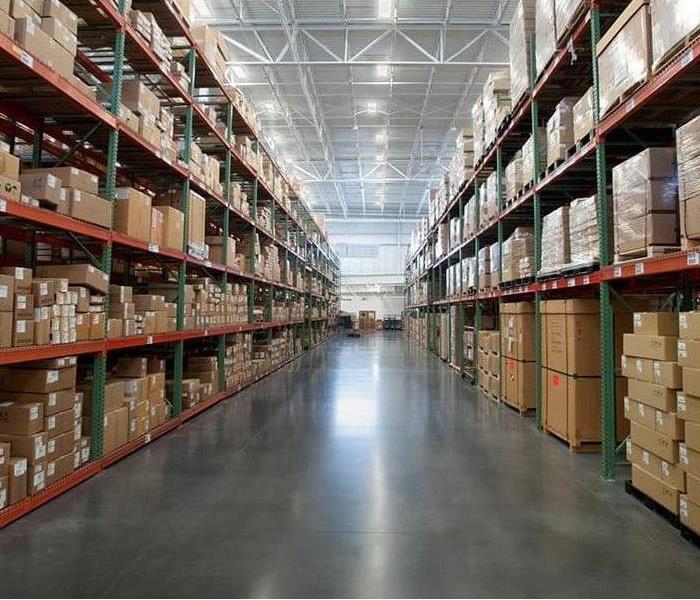 Mold can live in walls, behind wallpaper, under flooring, and in ceilings, and these are just the most common places.
Mold can live in walls, behind wallpaper, under flooring, and in ceilings, and these are just the most common places.
If you begin to detect the odors associated with mildew or mold in your warehouse, or if your employees are experiencing them, don’t wait to investigate. Mold can live in walls, behind wallpaper, under flooring, and in ceilings, and these are just the most common places. If your investigation doesn’t find anything, the next best way to determine if the smell is coming from a mold colony is to hire a certified mold inspector to stop by and check it out. They will be able to run the necessary tests to determine if you have a mold problem in your warehouse.
Some places to check for mold will be a basement or cellar area, or the bathroom. Mold will take hold in damp areas, so if there is a wall or a floor where dampness is an issue, mold will be attracted there. It will establish colonies in dark corners, as well. Scheduling periodic visual inspections in these areas will help to identify a mold colony before it becomes unmanageable.
If your warehouse has recently undergone a flooding event or significant leaks have developed recently, these will be situations that could promote a mold issue. Always consider areas with moisture as places you need to pay attention to.
The wetter times of the year are going to be important times to be vigilant when it comes to mold in your warehouse. Be aggressive when investigating the source of mold and addressing it. If you need help, call the mold remediation experts here at SERVPRO of North Richland Hills. We have the experience and skills needed to take care of the mold issues that can develop in your warehouse or business. We handle water damage and fire damage, too.
Mold: Let's Get It Taken Care Of
4/15/2019 (Permalink)
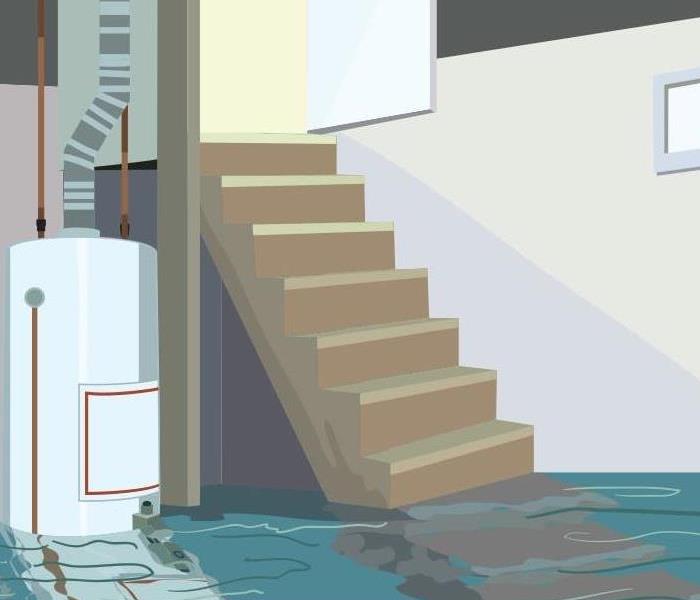 North Richland Hills, Texas - Don't leave mold up to chance. Let the certified professionals mitigate mold from your home.
North Richland Hills, Texas - Don't leave mold up to chance. Let the certified professionals mitigate mold from your home.
While we all love the warm weather in spring, there is something else that also loves spring weather.
MOLD. That’s right. It is lurking and waiting for the perfect conditions to wreak havoc on your home. Whether there is mold growing from that leaky pipe in the kitchen or the humid bathroom, all mold loves warm, wet conditions.
Mold loves the spring time. Wet conditions and warm weather mean a perfect environment for mold to grow in basements, bathrooms, under homes, in cabinets, in attics, and in garages.
If you have experienced water damage that wasn’t properly treated by IICRC standards, you could be at risk for mold exposure.
Well, don’t worry! SERVPRO of North Richland Hills is qualified and ready to service your mold growth.
From a wide array of services such as mold mitigation and remediation, reconstruction, and clean up, SERVPRO of North Richland Hills is a one stop shop for all your mold removal needs.
What could you expect from SERVPRO of North Richland Hills professionals during mold removal?
- Advisory solutions to test mold by an environmental hygienist.
- A standard protocol on how to remediate the specific mold in your home.
- A certified mold specialist with come out with a team and begin proper remediation.
- We handle the mold removal whether that is mitigation, remediation, reconstruction, and sanitation and clean up.
SERVPRO of North Richland Hills specializes in the cleanup and restoration of commercial and residential property after damaging event. Our staff is highly trained in property damage restoration. From initial and ongoing training at SERVPRO’s corporate training facility for regular IICRC-industry certification, rest assured our staff is equipped with the knowledge to restore your property. SERVPRO wants our team to be part of your team! Call us at (817) 589-1499 or follow us on Facebook, Instagram, and Twitter!
5 Spots Mold Plays Hide-N-Seek
10/17/2018 (Permalink)
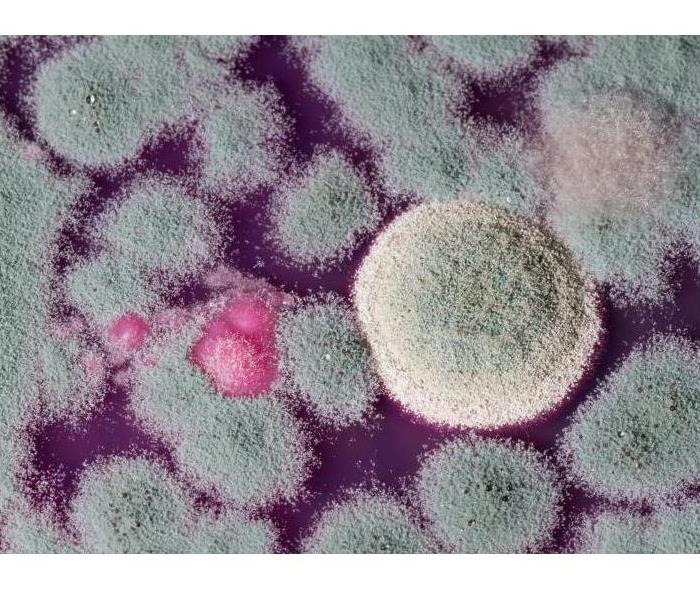 Fuzzy Mold That Feeds off Humid Temperatures! Stop the game of Hide-N-Seek with Mold.
Fuzzy Mold That Feeds off Humid Temperatures! Stop the game of Hide-N-Seek with Mold.
With all the rain, it is easy to get sick from cooler temperatures and warmer homes. Though, keep an eye on the hidden mold that grows in this perfect environment. Warm and wet regions of your home can be subjected to perfect mold conditions and affect your health.
5 Spots Mold Hides in Your Home
- Your Shower – the most common place where mold grows. Check around tile grout, washcloths and loofahs, and even your shower curtain.
- Your Sink – Any excess moisture creates a living environment where fungus thrives. Make sure to check around your faucets and in toothbrush caddies.
- Your Walls and Floors – If you have any leaky pipes, prepare to investigate because it’s a place where mold can grow while not being disturbed.
- Your Refrigerator – Expired food can be a hotbed for any growth and could affect your other food and health!
- Your Mattress – Excess moisture and the right temperature can encourage mold growth under your bed.
Avoid getting sick this season from unnecessary mold growth and keep your family and home safe from fungus.
SERVPRO of North Richland Hills Seeks and Mitigates!
SERVPRO of North Richland Hills specializes in the cleanup and restoration of commercial and residential property after damaging event. Our staff is highly trained in property damage restoration. From initial and ongoing training at SERVPRO’s corporate training facility for regular IICRC-industry certification, rest assured our staff is equipped with the knowledge to restore your property. SERVPRO wants our team to be part of your team! Call us at (817) 589-1499 or follow us on Facebook, Instagram, and Twitter!
Exactly What Is Black Mold and What should I Do If I Suspect Mold
8/16/2018 (Permalink)
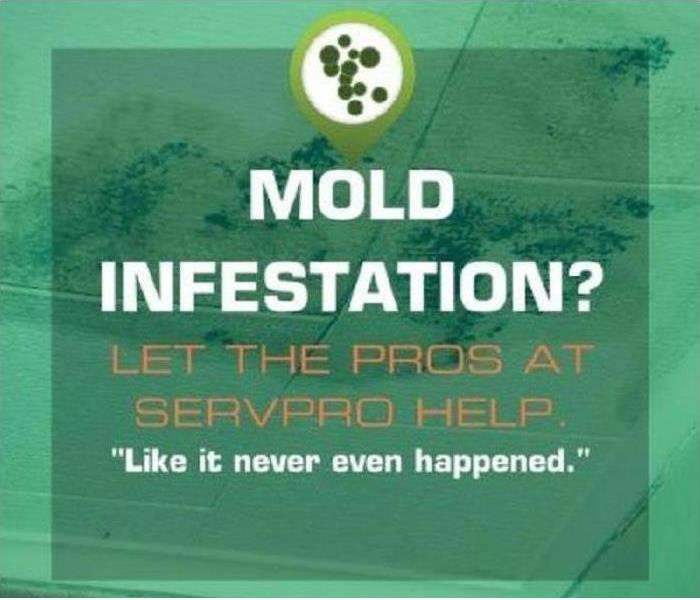 Mold infestation to your business? Let the professionals at SERVPRO of North Richland Hills help!
Mold infestation to your business? Let the professionals at SERVPRO of North Richland Hills help!
Not all varieties of mold found in your home or commercial business are toxic. Mold is just another word for fungi that occurs naturally in thousands of different varieties. Only a few are toxic to humans with black mold being on the top of the list of “usual suspects” when mold contamination affects the interior of a home or commercial business and the health of its occupants. Black Mold requires immediate professional attention. Long term exposure to black mold has been associated with a spectrum of symptoms including allergic reactions like hay fever, asthma attacks, headaches, nausea, dizziness and even depression.
The formal name for black mold is Stachybotrys Chartarum. This type of mold is particularly adapted to growing inside structures when minimal requirements of moisture and food are available. Like all mold, active black mold releases millions of microscopic reproductive spores. However black mold spores carry chemicals called mycotoxins that are known to be toxic to humans when inhaled.
Contrary to its name black mold is often not black. In fact, black mold maybe closer to green in color or appear to be various shades of brown as well. Keep in mind that other types of harmless mold can also assume this same coloration so if black mold is suspected inside a home or commercial building it can only be confirmed by a licensed mold remediation specialist who will test direct samples.
Successfully treating black mold in a home or commercial building is not a DIY project. Once the mold is tested a licensed and qualified mold remediation specialist can write up a protocol and begin remediation.
For more information or a licensed and qualified Mold Remediation Professional contact SERVPRO of North Richland Hills at 817-589-1499
Forth Worth Molded Garage
8/16/2018 (Permalink)
 Mold damage to a property in Fort Worth, Texas
Mold damage to a property in Fort Worth, Texas
These Fort Worth homeowners were on vacation and completely unaware of water that had penetrated in to their garage. While the water sat there for approximately 5-7 days, you can imagine the amount of mold growth that they found on their ceiling from the ongoing moisture.
Follow these steps if you believe you have mold in your home or business.
1. Emergency Contact - (817) 589-1499
2. Inspection and Mold Damage Assessment
We carefully inspect your property for visible signs of mold.
3. Mold Containment
Our professionals use various containment procedures to prevent the spread of mold.
4. Air Filtration
Our specialized filtration equipment allows our Professionals to capture microscopic mold spores out of the air.
5. Removing Mold and Mold-Infested Materials
The mold remediation process depends on the amount of mold growth and the types of surfaces on which the mold appears. We’ll use antifungal and antimicrobial treatments to eliminate mold colonies and to help prevent new colonies from forming.
6. Cleaning Contents and Belongings
We clean your furniture, decorative items, curtains, clothing, and other restorable items affected by mold.
7. Restoration
Depending on the level of mold damage, drywall, subfloors, and other building materials may have been removed.
3 Common Mold Causes
8/13/2018 (Permalink)
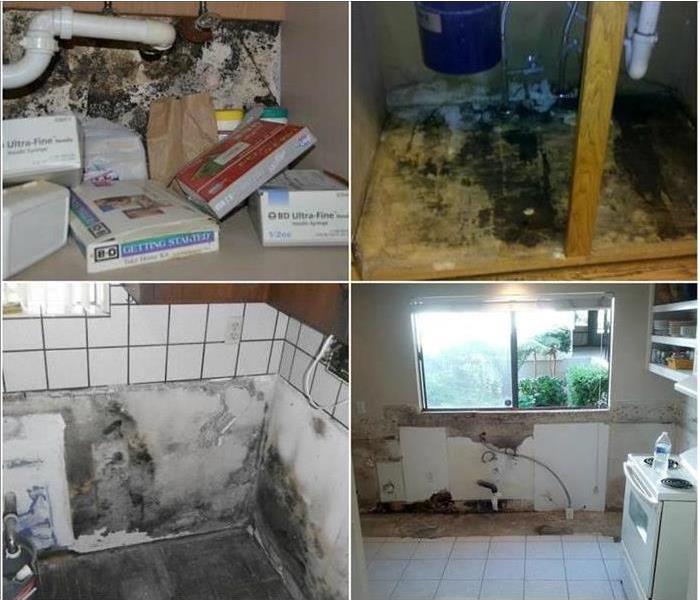 Common areas where mold is found.
Common areas where mold is found.
Mold or mildew odors in your home are sometimes an early indication of Mold growth. Mold often emits musty or other unpleasant odors and although the presence of a musty, moldy odor does not mean that you have a mold problem, it is one of the early indicators that you could have a hidden mold problem and should have it checked out as soon as possible. SERVPRO of North Richland Hills is here to help.
1. Plumbing Leaks
Hidden and undetected plumbing leaks often lead to extensive water damage and mold. Our SERVPRO of North Richland Hills technicians are experts at locating possible plumbing leaks and although some plumbing leaks are obvious other plumbing leaks may be hidden. Our state of the art moisture detection equipment helps locate and pinpoint moisture issues and hidden leaks. It is very important to act quickly once a plumbing leak is detected. According to the US EPA, mold can grow in 24-48 hours if building materials are not dried out quickly and properly.
2. Roof Leaks
Damaged, worn, or improperly installed roofs, roof flashing, chimney caps, rain gutters, and plumbing vent stacks can lead to roof leaks, which can lead to indoor mold growth and water damage.
3. Grading and Drainage Issues
Soils and landscaping should always slope away from a structure. Improper grading can cause water to run towards the foundation and walls instead of away. The water from rain and irrigation sprinklers can also invade the home and cause mold growth as well as water damage. Also, improper, failing, or missing rain gutter systems often cause water intrusion issues in residences and commercial buildings that is the source cause of many indoor mold growth problems.
Not so common areas where mold is found.
8/13/2018 (Permalink)
 Mold found in multiple areas in a North Richlands Home.
Mold found in multiple areas in a North Richlands Home.
We have put together a short list of problems that can lead to mold, mold odors, and damage to your home:
1. Foundation Leaks, Vapor Drive, or Crawl Space Ventilation
Dampness, excess humidity, and condensation from the foundation can be attributed to many issues such as leaks in plumbing, grading or drainage issues, improper construction, missing or improper vapor barriers, poor crawlspace ventilation, support beams and wood piers touching soil, and foundation cracks and settling.
2. Misaligned Sprinklers and Sprinkler System Leaks
Are your sprinklers spraying the side of your home, on your windows, or on your foundation? This condition can cause water damage and force water to enter the building envelope and intrude into walls and under flooring causing mold growth.
3. Failing or Poor Caulking or Grout in Showers and Around Tubs
Showers and tubs should always be well sealed to prevent water from getting into surrounding walls and underneath. Failing to apply or properly caulk or grout as well as improper construction of shower pans and tub enclosures are common causes of water intrusion and mold growth. Moisture in the surrounding building materials can not only lead to mold growth in your bathroom but also the adjacent walls.
If you suspect that you may have mold in your home or commercial business call SERVPRO of North Richland Hills at 817-589-1499 or visit our website at www.SERVPROnorthrichlandhills.com
Preventing Mold in Your Home
8/13/2018 (Permalink)
Taking preventative measures beforehand decreases chances of facing bigger problems later. Here are 2 steps that can be taken to prevent fridge mold.
1. Pay for Sterilization
If you feel that cleaning your home is too gross to handle, consider hiring a cleaning service to tackle the task. It may be a costly expense, but it will be worth it. Footing the bill for routine cleanings is better than having a mold outbreak.
2. Know Who To Contact
If the mold prevention measures you took didn’t work, make sure to contact your mold removal specialists in North Richlands. They have the expertise and state-of-the-art equipment to quickly remove mold as well as other hidden sources that may be mold-infested.
Getting a whiff of that dreaded mold smell and later discovering visible mold can be overwhelming and scary for homeowners. Follow the above steps to be proactive in your fight against mold rather than simply reactive after its formation.
Why does mold grow in my North Richland Home?
8/13/2018 (Permalink)
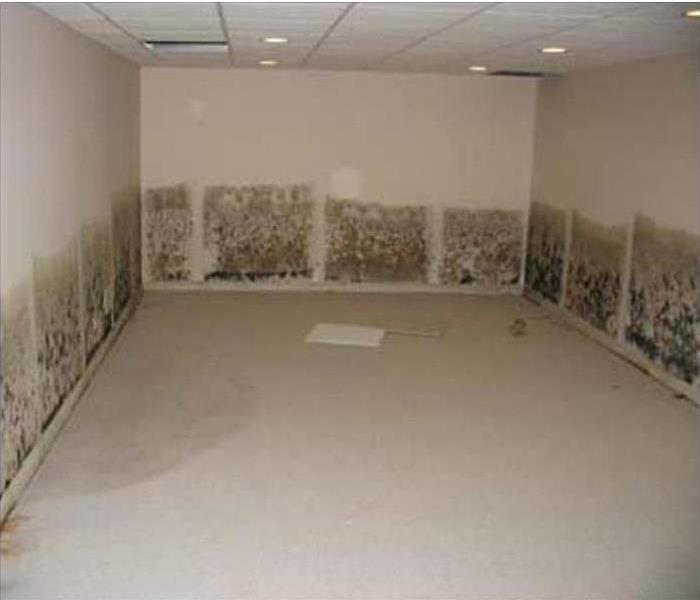 If you see MOLD in your home or business call SERVPRO of North Richland Hills at 817-589-1499
If you see MOLD in your home or business call SERVPRO of North Richland Hills at 817-589-1499
Did you know that microscopic mold spores naturally occur almost everywhere, both outdoors and indoors? This makes it impossible to remove all mold from a home or business. Therefore, mold remediation reduces the mold spore count back to its natural or baseline level. Some restoration businesses advertise “mold removal” and even guarantee to remove all mold, which is a fallacy. Consider the following mold facts:
- Mold is present almost everywhere, indoors and outdoors.
- Mold spores are microscopic and float along in the air and may enter your home through windows, doors, or AC/heating systems or even hitch a ride indoors on your clothing or a pet.
- Mold spores thrive on moisture. Mold spores can quickly grow into colonies when exposed to water. These colonies may produce allergens and irritants.
- Before mold remediation can begin, any sources of water or moisture must be addressed. Otherwise, the mold may return.
- Mold often produces a strong, musty odor and can lead you to possible mold problem areas.
- Even higher-than-normal indoor humidity can support mold growth. Keep indoor humidity below 45 percent.
If you suspect Mold in your commercial or residential building call SERVPRO of North Richland Hills. Our professional Mold team can inspect and access your property and use our specialized training, equipment, and expertise to remediate your mold infestation.
Call SERVPRO of North Richland Hills at 817-589-1499
Speedy Response: The Key to Mold Prevention
7/23/2018 (Permalink)
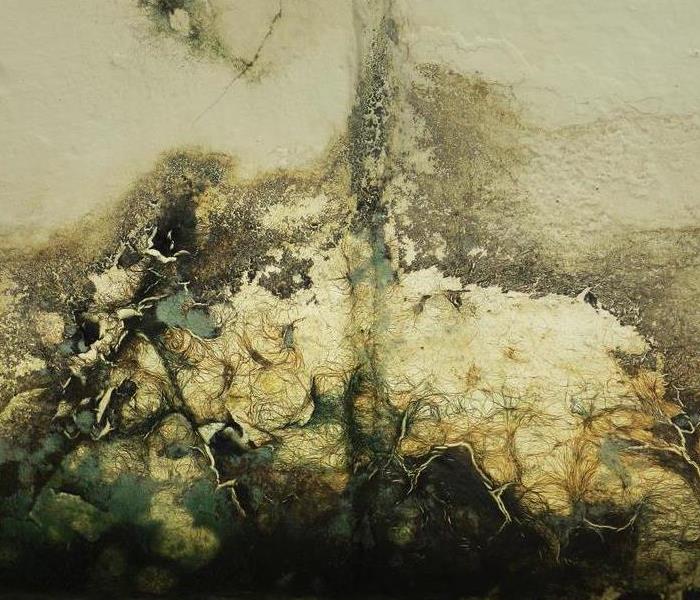 By acting quickly within the first 24 hours following the discovery of water damage, it is possible to prevent mold growth.
By acting quickly within the first 24 hours following the discovery of water damage, it is possible to prevent mold growth.
Mold is an invasive, destructive fungus that thrives in a moist, warm environment. Left unchecked, mold can begin to grow and spread on even slightly wet surfaces within building materials during the first 24–48 hours following an incident of water damage or water leakage. Such a fungal infestation can wreak havoc on the interior structure of a building, often resulting in thousands of dollars of damage.
Unfortunately, many property owners don’t know they have a problem until it is too late. If you do suspect an issue with your building in North Richland Hills, TX, it is important to act quickly.
Trigger Points
Many events can trigger mold growth, and, while some aren’t always obvious, other incidents should always raise a red flag. Here are some of the main causes of mold infestation which must never be overlooked:
• Flood
• Fire
• Roof or plumbing leak
• Damp basement
• Extremely high humidity
If your building has been impacted by any of these events, it is important to act immediately. Successful mold prevention begins upon the discovery of any water damage — no matter how small — or any event that could foster the dangerous combination of moisture and warmth.
Action Plan
Upon discovery of a potential mold-causing event, call a restoration specialist in North Richland Hills, TX, for an emergency assessment. While waiting for professional help, dry the affected area with mops and rags, remove wet rugs or carpeting, prop wet upholstery and cushions. Wipe any dampness from tables or objects. Mildew (the precursor to mold) can form on any wet surface, no matter how small.
By acting quickly within the first 24 hours following the discovery of water damage, it is possible to prevent mold growth. Once this window of opportunity is closed, the question of mold prevention is likely to be moot and the far more expensive process of tearing down, removing and replacing the damage caused by mold begins. For more information, visit http://www.SERVPROnorthrichlandhills.com/.
How To Prevent Mold in Your Swamp Cooler
5/14/2018 (Permalink)

You’ll never guess how swamp coolers got their name – and it’s not because they’re more effective in swampy areas. In fact, swamp coolers work less effectively in swampy areas. There are many running theories about how these alternatives to air conditioning came to be known as “swamp coolers,” but the chief theory is that the name comes from the swampy smell that rises when you have a leaking swamp cooler or don’t clean your swamp cooler well enough. And of course, that swampy smell rises from our number one enemy in Richland Hills, TX: mold.
Keeping Mold Out of Your Swamp Cooer
Because swamp coolers use water and convection to cool the air, they’re very vulnerable to mold infestations. If the standing water inside a swamp cooler begins to stagnate, the cooler begins to leak, or condensation begins to form on the outside because of temperature differentials, you may find your swamp cooler crawling with mold. To keep it clear:
1. Immediately inspect a leaking water cooler. Puddles forming underneath can prompt mold growth. If your leaking water cooler is beyond salvation, you may need to replace it.
2. Periodically empty and change the water in your swamp cooler. Fresh water is less likely to prompt mold growth than dirty or stagnant water.
3. Wipe the condensation from the outside of the cooler. This is particularly important in humid environments, and can also make sure your swamp cooler functions at max efficiency.
4. Frequently clean and dry out your swamp cooler. Dirt and grime mixed with water? Are a perfect recipe for mold. Meticulously clean your swamp cooler on a regular basis. This can mean fully emptying it and letting it dry out, and wiping it down thoroughly inside and out. You may even have to disassemble it to expose damp interior parts to the sun and open air, but anything is better than letting your swamp cooler live up to its “swampy” name. For more information, visit http://www.SERVPROnorthrichlandhills.com/.
Do You Suspect Mold in Your Home or Business?
8/11/2017 (Permalink)
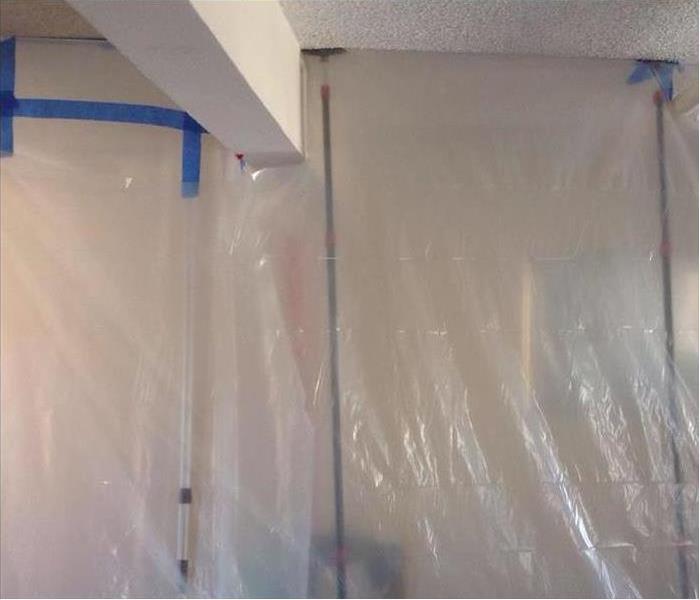 Proper containment is essential during the mold remediation process. Doing so prevents mold spores from contaminating unaffected areas.
Proper containment is essential during the mold remediation process. Doing so prevents mold spores from contaminating unaffected areas.
If you are a homeowner or a business owner and you suspect you might have mold in your home or business, it is very important that you act quickly because the longer you wait to investigate the worse it could get.
Stachybotrys chartarum is the type of mold often called black mold, and it does produce allergens and irritants. However, many types of mold can produce allergens and irritants. Treat any mold with caution – stay out of affected areas and don’t touch or disturb the mold.
When water intrudes into your property, mold growth can start in as little as 48 hours. Consider the following mold facts:
- Mold is present almost everywhere, indoors and outdoors.
- Mold spores are microscopic, float along in the air, and may enter your home through windows, doors, or AC/heating systems or even hitch a ride indoors on your clothing or a pet.
- Mold spores thrive on moisture. Mold spores can quickly grow into colonies when exposed to water. These colonies may produce allergens and irritants.
- Before mold remediation can begin, any sources of water or moisture must be addressed. Otherwise the mold may return.
- Mold often produces a strong, musty odor, and that odor can lead you to possible mold problem areas.
- Even higher-than-normal indoor humidity can support mold growth. Keep indoor humidity below 45 percent
SERVPRO of North Richland Hills specializes in Mold Remediation.
If you see signs of mold, call us today - (817) 589-1499
What to Expect During Mold Remediation
8/11/2017 (Permalink)
 Let SERVPRO of North Richland Hills help with your mold remediation!
Let SERVPRO of North Richland Hills help with your mold remediation!
Mold can grow almost anywhere in a home or business if conditions permit. If there is visible growth on painted wall surfaces, property owners should be concerned about what may be growing on the wall's opposite side. The environment inside the walls of a house often differs drastically from the outside and could create a perfect haven for mold. If the wall remains wet for a prolonged period, it's almost guaranteed that the mold growth on the back side will be worse than on the front. At that point, containing the work space and removing moldy materials, followed by cleaning of salvageable framing, are the best options.
Certified professionals have the training and experience to:
- Identify moisture sources
- Evaluate mold growth (visible or suspected)
- Contain damage to the smallest area possible
- Physically remove contamination
- Dry materials to ensure that mold will not return
- Perform or recommend procedures for returning property to a preloss condition
The IICRC outlines five major principles of mold remediation.
- Make sure safety and health precautions are taken by cleanup professionals and occupants. Mold-contaminated buildings can be associated with many health problems. Anyone involved in the mold remediation process must be protected from exposure through a combination of practices and controls.
- A post-cleanup assessment by an independent environmental expert. An effective mold remediation cannot be developed without first determining the extent of the contamination to be removed. To ensure that remediation work is being properly performed, it is highly recommended that appropriate documentation of the remediation process be kept by project management
- Control of mold before it spreads further. Eliminating mold at the source of contamination is essential. Once mold spores spread through the air, it will be much more difficult to capture.
- Oversee the proper physical removal of the mold. The mold must be physically removed from the structure. Attempts to isolate mold or remove signs of mold on the surface are not adequate. Note that bleach alone cannot kill mold.
- Ensure that moisture is controlled to limit future contamination or recontamination. Mold growth is virtually inevitable if moisture is not controlled. Moisture problems must be identified, located and corrected or controlled as soon as possible.
For more information call the SERVPRO of North Richland Hills experts at 817-589-1499
How to Detect and Prevent Carpet Mold
8/11/2017 (Permalink)
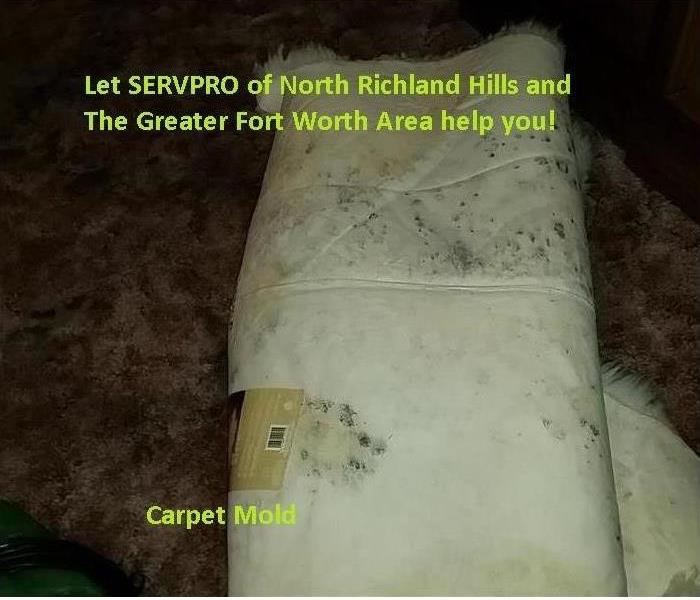 Carpet Mold? Let SERVPRO of North Richland Hills help!
Carpet Mold? Let SERVPRO of North Richland Hills help!
Hidden Mold
Carpet mold is very serious but often goes unseen. It develops beneath the carpet fibers making it hard to detect. A leak in one part of a house can trickle into another. This leads to nearly invisible carpet mold.
Detecting Carpet Mold
Some carpets are visibly moldy. They may look like white, black or green splashes on the carpet. These carpets need to be discarded. Carpets that are completely soaked probably have mold. A plumber might need to check for any leaky pipes within the walls. Wet carpeting must be cleaned and dried within 48 hours to ensure that mold has been completely removed. Mold in carpets is usually beyond repair. Professional cleaners may be able to quickly dry the carpet. They usually have the necessary equipment needed for fast mold remediation.
Mold usually has a distinct smell and the odor is unforgettable. If you see mold within your house, you may want to quickly smell it. You’ll be able to recognize it more easily in the future. There are a few different types of mold. Black mold is the most toxic. Those with black mold in house should get it removed immediately. It often appears in carpets and on walls. Black mold is dangerous because it is heavily associated with respiratory issues. It usually resembles black splotches in the carpet. It can also trail up against walls in thick lines. The circular patterns in black carpet mold may resemble burn marks.
How to Kill Mold
Killing mold in a carpet is almost impossible. Carpet mold usually seeps all the way through the fibers. It is better to focus on mold prevention and keeping the carpet clean. Carpets are less likely to visibly develop mold than other parts of the house. This is why mold detection is the key to prevention. Those looking to kill mold and mildew should consider hiring certified professionals like SERVPRO of North Richland Hills because there is health risks involved. Home cleaning methods may make the mold less visible, but the spores will still be embedded in the carpet.
Preventing Carpet Mold
The one major cause of mold is moisture. Reducing the humidity within a house is the best way to ensure mold goes away forever. You may want to invest in a dehumidifier. These are designed to suck moisture out of the air. Make sure that there aren’t any leaks within your house. Broken air conditioners and leaky bathroom pipes may create puddles that result in mold. Mold grows the most in places that are dark and damp. Mold prevention is harder in areas that are humid. Detailed cleaning of your carpet will greatly help in preventing mold.
For more information on mold remediation and detailed carpet cleaning contact SERVPRO of North Richland Hills at 817-589-1499




 24/7 Emergency Service
24/7 Emergency Service






















